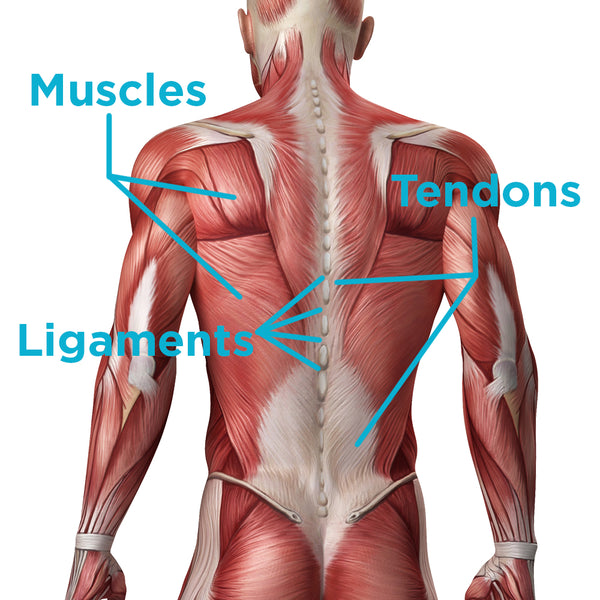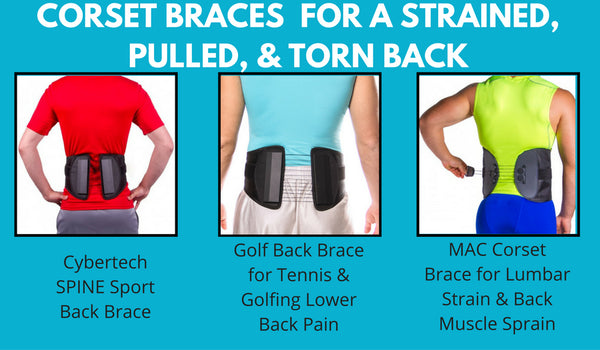What’s the Difference Between the Muscles, Tendons, & Ligaments in Your Back?

If you’re experiencing pain and discomfort in your back, it is likely you have either strained or sprained your back. So what does that mean exactly? Well, the discomfort that you are experiencing can occur in your muscles, tendons, and ligaments in your back. While all of these parts help to hold up and support your spine, they are composed and perform different functions!
- Muscles: Constructed of bundles of stretchy, fibrous tissue, which are connected to your bones and joints by tendons. This helps allow your body to move in many different positions.
- Tendons: Constructed of cords of sturdy, tough fibrous collagen tissue, which attach your muscles to your bones. These are strong but still flexible and help your muscles to move your bones and joints.
- Ligaments: Constructed of slightly elastic fibrous tissues, which connect two or more bones together. This helps stabilize your joints while you are sitting or standing still and prevent excessive movement injuries such as hyperextension and hyperflexion.
Still confused? Read more about the anatomy of your back, it's muscles, tendons, and ligaments.
Did I Sprain or Strain My Back?
Sprains and strains are very commonly confused with one another but both are essentially soft tissue injuries. The muscles in your back can get strained whereas the ligaments in your back can get sprained.
A sprain occurs when a ligament stretches or tears.
A strain occurs when a muscle or tendon stretches or tears.
Some of the common causes of a strained or pulled back muscle include:
- Heavy lifting
- Sports such as basketball, football, and golf that require frequent twisting/turning
- Trauma or a fall
- Poor posture
- Obesity
Those who have a pulled or torn muscle in their back might experience soreness or tenderness, especially in the region of your injury. In addition, symptoms of a pulled muscle may include pain that worsens when you stand, walk or twist. Some individuals experience pain that radiates to your legs, buttock, and thigh area.
Why Do I Need A Brace For A Pulled or Strained Back Muscle?
Wearing back support braces help provide stability to your spine, especially for those involved in lifting or sports. These braces for back strain treatment help to reduce the amount of twisting or bending your spine may endure throughout the day.
In addition, compressing your spine and back region can help reduce swelling after an injury and promote a quicker healing process. This level of compression for a pulled back muscle will help to reduce your discomfort.
It’s important to note you shouldn’t completely rely on such bracing for a strained muscle. If you suffer from a pulled back muscle, you should wear a brace support for only a certain amount of time. In order for your back to heal, it needs time to strengthen your muscles again. Only relying on such supports can lead to loss of strength in your back, spine, and shoulders.
Which Brace for a Pulled Back Muscle Treatment Would Work the Best for Me?
Corset Brace Treatments:
The corset braces suggested below can help provide comfort, support, and immobilization of your lumbar back region. These are great for back muscle pain relief because they enable you to control the level of compression you apply to your back. Whether you need maximum compression or a little, you can adjust these braces for your specific condition.

Compression Wraps:
Compression wrap support braces are also good options for torn back muscle treatment because they provide abdominal and back compression. This compression ultimately improves blood flow to your back, which as mentioned above makes for a quicker recovery time. Read more below for in-depth descriptions and features of the selected braces.

Lower Back Muscle Strain Belt: This low-profile belt can help reduce the pain caused by a muscle strain and its slim design allows you to wear this wrap treatment beneath or over your clothes. This completely adjustable brace allows you to apply compression quick and easy. Because people of all shapes and sizes find themselves in need of lower back muscle pain treatment, this band comes in eight different sizes fitting hip circumferences ranging from 18 inches to 60 inches. For larger sizes, consider our plus size back brace that is available in sizes up to 6XL.
Women’s back brace: This female back brace provides abdominal pressure, which takes pressure off the lumbar back. Plus, it makes this support multi-functional in instances where both lower abdominal pain and back pain in women are at play. The compression reduces inflammation that can be one of the reasons for lower back pain in women. It also improves blood flow to the low back, which encourages quick healing.
Women can be prone to numerous different back conditions besides a strained or pulled back. For example, SI joint pain, C-section recovery pain, and pregnancy pain are a few examples in which women are more likely to experience. Read our blog post on all the different types of back supports that work for different conditions in women.
Elastic & neoprene back brace: This brace is flexible and it’s elastic material allows for movement while also stabilizing the back and applying the much-needed compression to the area of the lower back that is in pain. It also comes with inserts that can be placed in the pocket of the neoprene back brace help to add extra support and compression. This is highly recommended for a strained back treatment of the lumbar region.
Plus size bariatric brace: This back muscle tear treatment belt can also help with discomfort related to being overweight or obese. If one is overweight, this plus-size back brace for the low back strain can enable an individual to partake in a more active lifestyle by supporting the lumbar back and applying compression to reduce inflammation that is often the source of pain.
Ice and heat wrap: I’m sure you’ve heard before how beneficial ice and heat therapy is for different injuries but it can be extremely helpful for lower back strains and sprains. Heat wraps for back pain help open up your blood vessels, which increases blood flow and the stream of oxygen and nutrients to the joints, muscles, ligaments, tendons, etc. For that reason, heat therapy for back pain also relaxes sore muscles and improves flexibility and range of motion. Using an ice pack for lower back pain slows the flow of blood to an injury site. The reduced circulation reduces lower back muscle inflammation and discomfort.
Lifting Braces:
Do you lift weights frequently or have an occupation that requires you to lift heavy objects? Well, you are definitely more prone to strains and sprains in your back!
Wearing a back belt for lifting can ease pain for low back sprains and strains while also avoiding further tearing and injury to the ligaments. These lifting brace treatments can also be used for preventative purposes while you perform heavy lifts. It’s important to note that individuals should not wear the back belt for lifting around the clock. Doing so can cause the muscles of the back to weaken and lose their strength and flexibility, leaving you more prone to injury in the future.

If you are a frequent weightlifter or are a mover, construction, or warehouse worker, you may be using improper lifting techniques resulting in your back pain. Learn the 7 proper lifting techniques to help prevent injury and back sprains.
What To Do For Strained Back Relief: Other Treatment Options
Besides wearing the braces suggested above, there are many at home treatment options you can do to help lower your pain and discomfort caused by a pulled back muscle. You can try these treatment options in addition to wearing a back brace.
Here are some ways to help treat your sprained lower back muscle:
- Anti-inflammatory medications
- Rest
- Lumbar strain exercises
- Physical therapy
- Correcting your posture: wearing a brace such as this posture support is an easy way to train your muscles to stand in the correct position, promoting good posture


















